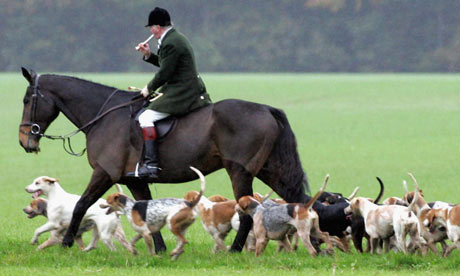Quarry
The most obvious animal welfare concerns regarding fox hunting would surround the quarry, the fox. Typically, the specific species of fox hunted is the Red Fox (Vulpes vulpes), however, in North America, the coyote is also a common quarry, due to their common presence. There are some very clear concerns over the suffering of the quarry during the hunt. During a hunt, the quarry is exposed to extremely high levels of distress as the quarry is hunted by a large pack of animals for many hours, often to the point of near exhaustion. This is especially a concern because the red fox does not have any natural predators, and so they have not evolved to deal with the physical and mental stress of being chased. Once the fox quarry has been cornered, the fox or coyote is at the mercy of the dogs, which are trained to kill. Often times, the fox is killed due to cervical dislocation, but in many cases they are mutilated during the kill, as the quarry and hound fight to the death. The Burns Report contains post mortem studies of foxes killed in hunts, and the results show that the neck or face is undamaged in some cases, suggesting that death is caused by painful damage to the internal organs. Even if the fox manages to survive the ordeal, it may be injured, and continue to suffer for an extended period of time. Although current laws have made it illegal for the foxes to face their death in such a horrific manner, the current “ban” on fox hunting still permits a member of the hunt to “humanely” kill a fox by shooting it. The implication of the current laws shows that it is still reasonable to make a wild and innocent animal suffer for the purpose of entertainment, as long as the suffering is done “humanely”, and not at the hands of another animal.
Hounds
Although a number of breeds can be used in fox hunting, the majority of fox hunting packs are composed of foxhounds. Foxhounds are bred specifically for the purpose of the hunt, endowing them with a number of necessary traits, including: strong nose, high stamina, pack mentality, speed, drive and courage as well as discipline. Foxhound breeding is tightly regulated and recorded. Specific breed requirements are necessary in order to officially register the hound as part of a pack for the Masters of Foxhound Association (MHFA), the governing body of fox hunting in England and Wales.
There is not much concern for the welfare of foxhounds in the sport of fox hunting, since ownership of a pack is usually by those who can afford to take decent care of them. Unfortunately, fox hounds are often injured, and sometimes killed, during a hunt. Once the scent of the quarry has been caught, foxhounds are said to become completely unaware of their surroundings, leading to a number of painful injuries from contact with branches and barbed-wire fences. In some instances, when the chase is taken across a busy road, the hounds may on occasion be hit by traffic. Because a pack of foxhounds can be quite large, owners of an injured foxhound may opt to “euthanize” them in order to save money.
Horses
Because horses are very commonly used in fox hunting, all the welfare and ethics concerns regarding horse ownership are encompassed within the issues surrounding the sport. Notably, the most direct concern for the horses due to fox hunting is the damage and suffering that can occur to the horses during the hunt. Once a chase is under way, the horses are forced to run at very high speeds, through treacherous territory. In some cases, these chases can lead members of the hunt through a busy country road, where they are exposed to moving traffic. In many instances, these conditions result in an injury to the horses. Because the horses may not be capable of recovering fully, the horses are often “euthanized” by their owners.
Unfortunately, a complete ban of fox hunting may present some welfare concerns for horses as well. In 1997, the Horse and Pony Taxation Committee sent a paper on the costs involved if hunting were to be abolished to the Treasury Ministers. This paper reported that up to twenty thousand horses would be slaughtered as a result of an effective ban on fox hunting. This number, however, is likely a gross exaggeration, due to the biased nature of the authors, especially considering that the horses involved in fox hunting could potentially be trained and prepared for other uses, or reused for alternatives to fox hunting.



